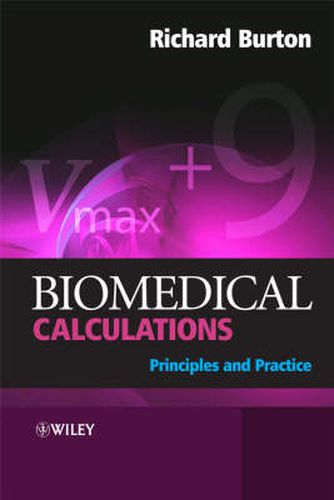Readings Newsletter
Become a Readings Member to make your shopping experience even easier.
Sign in or sign up for free!
You’re not far away from qualifying for FREE standard shipping within Australia
You’ve qualified for FREE standard shipping within Australia
The cart is loading…






‘It is said if you take care of the pennies, the pounds will take care of themselves. Richard Burton’s excellent book takes this approach to calculations applied to the biomedical sciences…This is certainly interesting and engaging but it avoids being complicated’ - Journal of Biological Education, April 2009 . Biomedical Calculations: Principles and Practice is an accessible, student-friendly introduction to calculating, applying formulae and solving quantitative problems within these subjects. This book targets a problem area for many students and aims to give them the confidence which they are so often lacking when undertaking scientific calculations. It takes a unique approach to the subject and uses unit analysis as a central theme throughout the book to enhance student understanding. Clearly structured throughout, little basic knowledge of mathematics is assumed, but even the most numerate readers will be interested in the sometimes-novel biological detail. Numerous worked examples, supplementary questions and practice problems are provided and although the book is written to be read in sequence, it will also be a useful reference. The central theme of the book focuses on the value of unit analysis in solving quantitative problems, with explanations on how to avoid errors in calculations and in checking, understanding and deriving formulae and equations. As a background to this, there is extensive treatment of physical units, both individually (e.g. kg, m, mmol) and in combination (e.g. m s ~ , mmol L ~ ‘), and also of other aspects of quantitative thinking. A variety of topics (mostly from physiology, pharmacology and biochemistry) are used to demonstrate these calculations in practice. This is an accessible, student-friendly introduction for all those hesitant in calculating, applying formulae and solving quantitative problems. This book presents an innovative approach to scientific calculations and how to work with unfamiliar formulae for the biomedical and life sciences. It includes modern, up to date definition of pH eliminating the need for logarithms and a discussion of the importance of pH. Clear introduction on how to use the book, guidance on units and unit conversion, and an appendix on basic mathematics and notation. This book discusses the use of unit analysis as a central theme. It includes numerous worked examples and supplementary questions throughout the text to enhance student understanding.
$9.00 standard shipping within Australia
FREE standard shipping within Australia for orders over $100.00
Express & International shipping calculated at checkout
‘It is said if you take care of the pennies, the pounds will take care of themselves. Richard Burton’s excellent book takes this approach to calculations applied to the biomedical sciences…This is certainly interesting and engaging but it avoids being complicated’ - Journal of Biological Education, April 2009 . Biomedical Calculations: Principles and Practice is an accessible, student-friendly introduction to calculating, applying formulae and solving quantitative problems within these subjects. This book targets a problem area for many students and aims to give them the confidence which they are so often lacking when undertaking scientific calculations. It takes a unique approach to the subject and uses unit analysis as a central theme throughout the book to enhance student understanding. Clearly structured throughout, little basic knowledge of mathematics is assumed, but even the most numerate readers will be interested in the sometimes-novel biological detail. Numerous worked examples, supplementary questions and practice problems are provided and although the book is written to be read in sequence, it will also be a useful reference. The central theme of the book focuses on the value of unit analysis in solving quantitative problems, with explanations on how to avoid errors in calculations and in checking, understanding and deriving formulae and equations. As a background to this, there is extensive treatment of physical units, both individually (e.g. kg, m, mmol) and in combination (e.g. m s ~ , mmol L ~ ‘), and also of other aspects of quantitative thinking. A variety of topics (mostly from physiology, pharmacology and biochemistry) are used to demonstrate these calculations in practice. This is an accessible, student-friendly introduction for all those hesitant in calculating, applying formulae and solving quantitative problems. This book presents an innovative approach to scientific calculations and how to work with unfamiliar formulae for the biomedical and life sciences. It includes modern, up to date definition of pH eliminating the need for logarithms and a discussion of the importance of pH. Clear introduction on how to use the book, guidance on units and unit conversion, and an appendix on basic mathematics and notation. This book discusses the use of unit analysis as a central theme. It includes numerous worked examples and supplementary questions throughout the text to enhance student understanding.